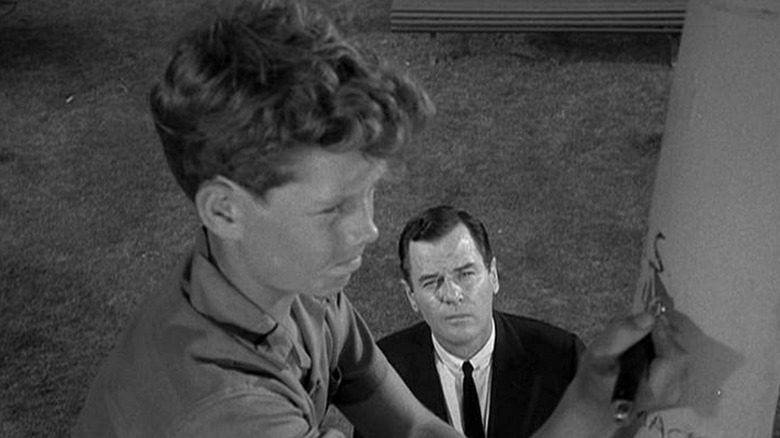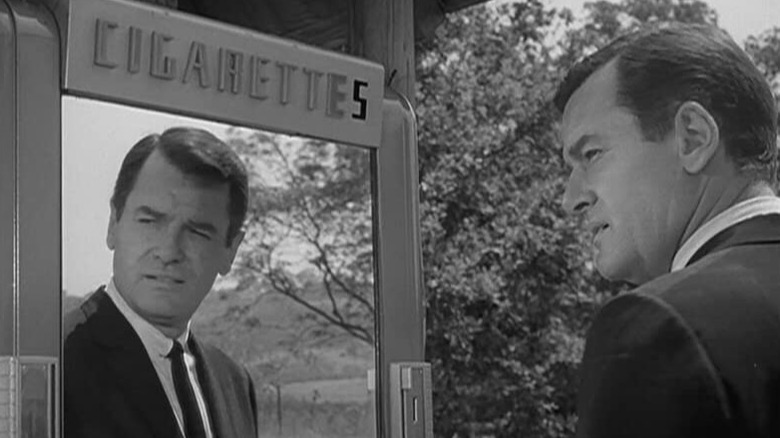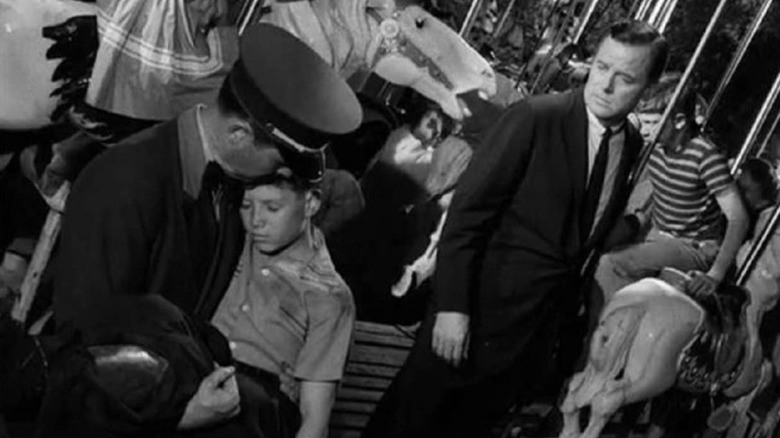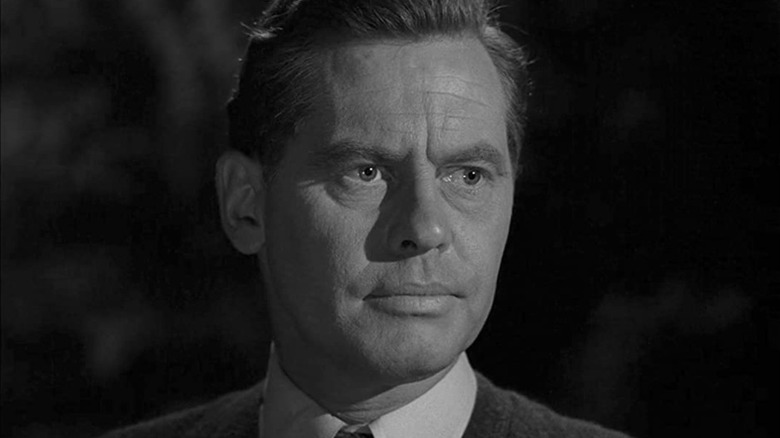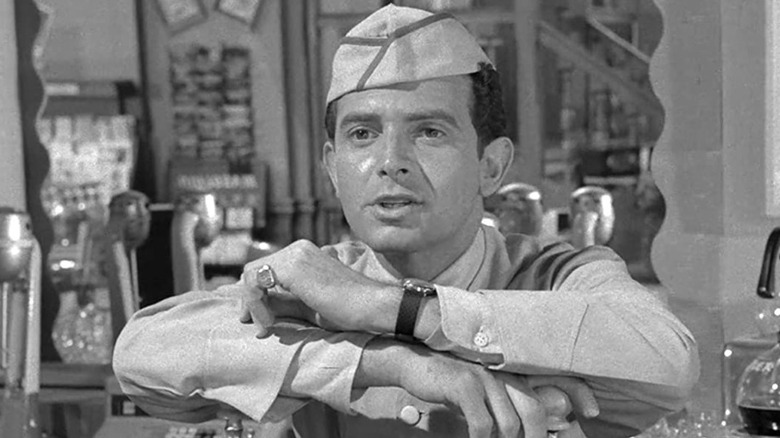This Twilight Zone Story Was Very Personal To Rod Sterling
"The Twilight Zone" contains multitudes. Some episodes are famous for their twist endings ("To Serve Man"), others for their stark, unnerving horror ("It's a Good Life"). Some are sweet and sentimental ("The Night of the Meek"), while others are morality plays ("The Monsters Are Due on Maple Street"). Your choice of "Twilight Zone" episode is as good a litmus test as any for your artistic preferences. What scares you more: dummies, dolls or dinosaurs? Do you find sweet robot grandmothers adorable or overly saccharine? Do you gravitate toward acknowledged classics like "Nightmare at 20,000 Feet," or do you stump for underrated masterpieces like "The Invaders?"
Rod Serling, the host of "The Twilight Zone," always had a clear favorite. It is an episode that is very unlike the popular conception of the series. There is no twist ending, no ghouls or ghosts to be found. But it may be the most personal script of the series that Serling ever wrote: the fifth episode of the very first season, "Walking Distance."
A man can walk a lot of pavements between afternoon and night
In case you haven't seen it, the story of "Walking Distance" goes something like this. Martin Sloan (played by Gig Young) is the vice president of an advertising company in New York. Frustrated with the fast pace of city life, he takes a drive upstate. There he leaves his car at a gas station and takes a mile-and-a-half walk to his hometown of Homewood. He steps into an ice cream shop and orders three scoops, surprised that they cost no more than they did when he was a child. As it happens, his journey home took him not just through space, but through time.
For a single night, he relives a warm childhood summer. The streets swarm with children, the merry-go-round turns, and cotton candy is sold at the side of the road. But his parents shut the door in his face, and his child self runs from him and badly hurts his leg. Martin himself falls to the ground, his own leg burning with pain. Chastened by the experience, Martin steps through time back to present-day New York City. For in the words of his father, "We only get one chance ... this is his summer, just as it was yours once. Don't make him share it."
The distant music of a calliope
"Walking Distance" is unlike many "Twilight Zone" episodes commonly considered classics. It has no shocking twist or supernatural creatures. Its meaning is solely personal rather than political. But "Walking Distance" has always had its champions. Director J.J. Abrams named it as his favorite episode back in 2009, calling it proof that "'The Twilight Zone,' which everyone thinks is a scary show ... [is] actually a beautiful show." In an essay for TalkHouse, legendary crime novelist and pinch-hitter on "The Wire" George Pelecanos says the episode "posits the question that good art asks and, naturally, can never answer: Why are we here?" When it came time for writer Noel Murray to assemble a list of 10 representative "Twilight Zone" episodes for The A.V. Club, you can bet that "Walking Distance" had a spot on the list.
"Walking Distance" represents an early high-water mark for "The Twilight Zone" from a craft perspective. Together with the pilot, it is one of only two episodes in the series that was directed by Robert Stevens. Stevens was a veteran of TV suspense programs of the time, who created notable episodes of anthologies like "Alfred Hitchcock Presents" and "Suspense." He brought to "Walking Distance" his eye for detail and skill at manipulating the camera, assisted by series cinematographer George T. Clemens.
The episode went far over budget and schedule, and Stevens was never invited back to the series to direct an episode again. But the results speak for themselves. "Walking Distance" uses every tool in its arsenal — lighting, props, mirrors — to suggest a beguiling, fantastic atmosphere. You never see a time machine, but you will believe that the carousel is alive.
Across his mind there'll flit a little errant wish
If you look closely, "Walking Distance" is packed with details drawn from Rod Serling's own life. His hometown of Binghamton, New York, has a carousel just like Homewood does. Near the carousel you will find a gazebo with a plaque that reads "Rod Serling: Creator of The Twilight Zone." In "Walking Distance," Martin sees his younger self etching his name onto a very similar gazebo. Serling's daughter Jodi remembers that her father, just like his avatar in "Walking Distance," found himself drawn back to his old stomping grounds again and again. Every summer, "he would ride an hour to Binghamton, New York, and visit his hometown. It was like his private journey of seeing his old home." Binghamton would reward Serling handsomely for his attention, marking its streets and corners with references to episodes of "The Twilight Zone."
The key to "Walking Distance," though, is its insistence that while nostalgia provides comfort, it cannot be a cure. Martin's longing for Homewood's past is perfectly understandable. The ice cream is good and cheap, the air is warm, and cotton candy is sold on the side of the road. But there is no room for an adult Martin there anymore. At the end of the night, he is told by his young father, in a voice that is kind but strict, that he must leave. When Martin returns to the Homewood ice cream shop in the present, the man at the counter asks if his bum leg came from fighting in the war. Serling would know; he lost his father while on duty in the military.
Martin's greatest fear in "Walking Distance" is not a world without cotton candy, but a world where he will never be able to speak to his father again. Martin must learn this lesson, just as Serling did, that while you can go home again, you can never really go back.
Some wisp of memory not too important
In her review of "Walking Distance," TV critic Emily St. James wrote that "our whole country is trapped in a nostalgia snare, longing for a small town world we haven't really existed as for a good 75 years."
The review was written in 2011, but it's equally true now. The merry-go-round of pop culture continues to churn, bringing back boy bands, blockbusters, and classic anime hits. "The Twilight Zone" is no exception, subject to yearly Syfy channel marathons as well as the occasional remake.
It's tempting to dismiss the show as retro kitsch, engrossed with ideas that ceased being relevant decades ago. Yet the benefits and costs of nostalgia has always been a central concern of "The Twilight Zone," not a byproduct. "Walking Distance" is as relevant now as it was when it aired. Just as it has never been more tempting to dream of the past, it has never been more fatal. The key is in the engine, New York City is ahead, and the waters are rising.
